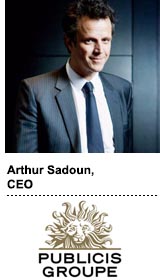
Holding companies are in a period of slow growth and organizational upheaval as clients cut spending while demanding new services and business models from their agencies.
Of the big six holding companies, Publicis Groupe has undergone the biggest disruption since it purchased Sapient for a whopping $3.7 billion in 2014 and later wrote down the acquisition by almost half its original price. The group’s organic growth slipped below zero in Q1 2017, only to inch up to 2.2% by the end of Q4.
At an investor event in London on Tuesday, Publicis Groupe CEO Artur Sadoun detailed a strategic plan to drive 4% organic growth, or $1.1 billion, by 2020, while reducing costs by $550 million and increasing margins by 30 to 50 basis points.
Publicis’ plan will better leverage the technology and business transformation capabilities it gained from Sapient back in 2014. It also involves the reorg of its business around single P&Ls for client and country leaders and eliminating costs by offshoring talent and creating back-office savings.
“This 4% growth comes from different levers than the traditional holding companies,” Sadoun said of Publicis’ digital business transformation capabilities. “This is what we’re trying to accelerate, because we know there is more growth there.”
While Publicis’ plan has been unfolding since the company’s 2014 Sapient acquisition, it’s just now starting to bear fruit. Publicis’ new proposition won business from Mercedes-Benz, Campbell’s and Marriott this year, and it has also begun leveraging centralized data and technology, such as the Publicis People Cloud and Publicis Spine, on client-centric teams.
Because the new model offers opportunities to cross-pollinate accounts with previously siloed business services, such as media and creative, it expects to realize about $370 million in savings through cross-selling opportunities in the next three years, Sadoun said.
“Mature business is an opportunity to bring transformation,” he said. “The most precious asset we have is the relationship with our historical clients.”
To facilitate client-centric accounts, Publicis will expand the number of global client leaders assigned to its top 100 clients, with client-centric work representing half of all revenue by 2020. It will also expand its country-level leadership, which puts countries on single P&Ls, to all markets within three years. The nimbler structure will to save an additional $37 million by 2020.
“We believe our brands are very important because this is how we manage culture and conflict,” Sadoun said. “But if tomorrow one brand [sees] revenue decline because of a client, our country structure breaks the silos between P&Ls so we can move people from one brand that’s declining to another.”
Amid cost savings, Publicis will spend roughly $120 million on bolt-on acquisitions each year until 2020. It will also create six centers of excellence around dynamic creative to better deploy personalized campaigns at scale.
Data, technology and dynamic creative, which together represent a 16% share of the group’s business today, will make up 30% of the business and account for 70% of total growth by 2020. Publicis will also scale up on talent in these areas by investing roughly $370 million, but recruitment will focus on countries such as India, Costa Rica and Mauritius, where technical talent is both cheaper and more accessible.
“We know exactly what we’re looking for,” Sadoun said. “We won’t go into any [acquisition] target if it doesn’t focus on data, dynamic creative or tech, and we’ll do it in a very disciplined way to make sure it’s easier for talent. We won’t go into an acquisition that isn’t maximizing growth and value.”
Finally, Publicis predicts that 90% of its employees will be connected to Marcel, the group’s AI-driven operating system for internal communications, by 2020.
Publicis will measure success by tracking the revenue generated by each of its new client-centric services, the share they represent with its top 100 clients and their share of the group’s growth. It will also look at the number of global client leaders, percentage of revenue coming from the country model and the headcount working for tech and data services.
“We know that we are in the race for transformation,” Sadoun said. “In our industry, there’s no doubt that there will be very few winners.”
This post was syndicated from Ad Exchanger.

More Stories
The Real Media Collective’s merger with Visual Media Association symbolic of shared vision
Jolie Sherman Returns to Detroit as Reporter
NZME focuses on digital transformation with new streaming service